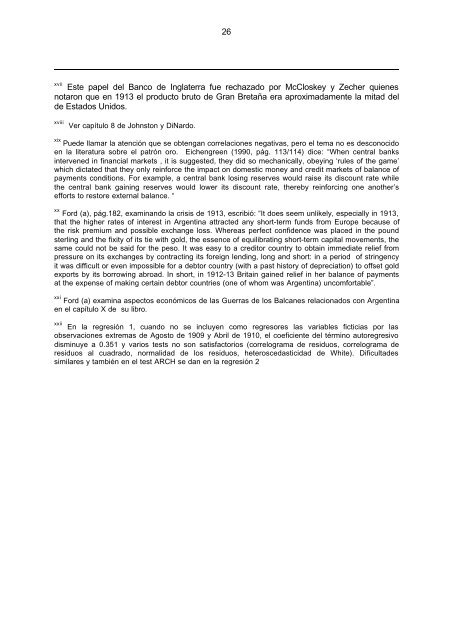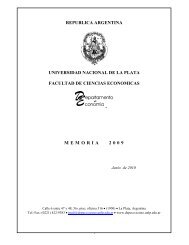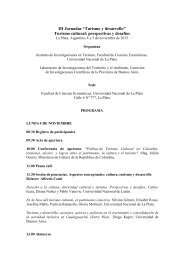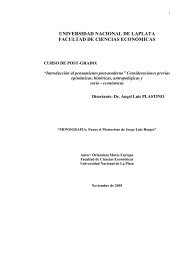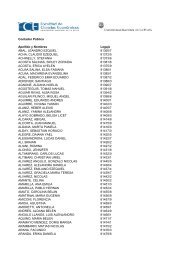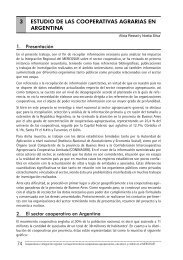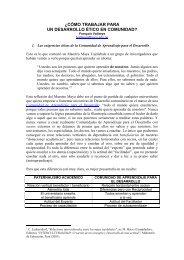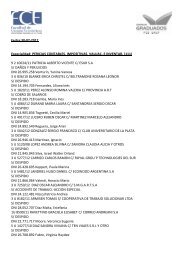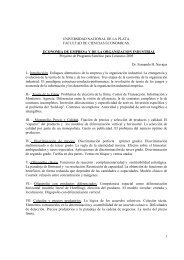Los flujos de oro y el ajuste externo Argentina 1903-1913
Los flujos de oro y el ajuste externo. Argentina 1903-1913
Los flujos de oro y el ajuste externo. Argentina 1903-1913
Create successful ePaper yourself
Turn your PDF publications into a flip-book with our unique Google optimized e-Paper software.
26xviiEste pap<strong>el</strong> <strong>de</strong>l Banco <strong>de</strong> Inglaterra fue rechazado por McCloskey y Zecher quienesnotaron que en <strong>1913</strong> <strong>el</strong> producto bruto <strong>de</strong> Gran Bretaña era aproximadamente la mitad <strong>de</strong>l<strong>de</strong> Estados Unidos.xviiiVer capítulo 8 <strong>de</strong> Johnston y DiNardo.xix Pue<strong>de</strong> llamar la atención que se obtengan corr<strong>el</strong>aciones negativas, pero <strong>el</strong> tema no es <strong>de</strong>sconocidoen la literatura sobre <strong>el</strong> patrón <strong>oro</strong>. Eichengreen (1990, pág. 113/114) dice: “When central banksintervened in financial markets , it is suggested, they did so mechanically, obeying ‘rules of the game’which dictated that they only reinforce the impact on domestic money and credit markets of balance ofpayments conditions. For example, a central bank losing reserves would raise its discount rate whilethe central bank gaining reserves would lower its discount rate, thereby reinforcing one another’sefforts to restore external balance. “xx Ford (a), pág.182, examinando la crisis <strong>de</strong> <strong>1913</strong>, escribió: “It does seem unlik<strong>el</strong>y, especially in <strong>1913</strong>,that the higher rates of interest in <strong>Argentina</strong> attracted any short-term funds from Europe because ofthe risk premium and possible exchange loss. Whereas perfect confi<strong>de</strong>nce was placed in the poundsterling and the fixity of its tie with gold, the essence of equilibrating short-term capital movements, thesame could not be said for the peso. It was easy to a creditor country to obtain immediate r<strong>el</strong>ief frompressure on its exchanges by contracting its foreign lending, long and short: in a period of stringencyit was difficult or even impossible for a <strong>de</strong>btor country (with a past history of <strong>de</strong>preciation) to offset gol<strong>de</strong>xports by its borrowing abroad. In short, in 1912-13 Britain gained r<strong>el</strong>ief in her balance of paymentsat the expense of making certain <strong>de</strong>btor countries (one of whom was <strong>Argentina</strong>) uncomfortable”.xxiFord (a) examina aspectos económicos <strong>de</strong> las Guerras <strong>de</strong> los Balcanes r<strong>el</strong>acionados con <strong>Argentina</strong>en <strong>el</strong> capítulo X <strong>de</strong> su libro.xxiiEn la regresión 1, cuando no se incluyen como regresores las variables ficticias por lasobservaciones extremas <strong>de</strong> Agosto <strong>de</strong> 1909 y Abril <strong>de</strong> 1910, <strong>el</strong> coeficiente <strong>de</strong>l término autoregresivodisminuye a 0.351 y varios tests no son satisfactorios (corr<strong>el</strong>ograma <strong>de</strong> residuos, corr<strong>el</strong>ograma <strong>de</strong>residuos al cuadrado, normalidad <strong>de</strong> los residuos, heteroscedasticidad <strong>de</strong> White). Dificulta<strong>de</strong>ssimilares y también en <strong>el</strong> test ARCH se dan en la regresión 2


